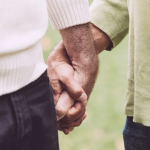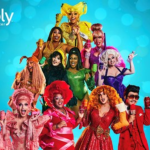Last November, Corona was a beer, you only saw face masks at the dentist, and dyke nightlife was popping off all around the world. A year ago, on a bitingly cold Sunday afternoon in New York, SAGE celebrated their Annual Women’s Dance — as they had done every year for 36 years — at the legendary Henrietta Hudson bar. The dances are fundraisers for SAGE, the world’s largest and longest-running organization for LGBTQ+ seniors. Under the motto “we refuse to be invisible,” they provide vital allyship for older queer folks, advocating in fields spanning housing, discrimination, caregiving, and HIV/AIDS. The organization is a cornerstone in NYC’s queer activist community; when they throw a party, people show up.
I’m going to take you to that night, straight into the beating heart of the dance floor, because if there’s one thing any of us need right now, it’s a bloody good night out, faces you know and don’t, and a baseline surging simultaneously through your beautiful spine.
**
The bar was heaving with some of the most embodied, empowered, liberated women you’ve ever seen on a dance floor in this city. People conversed, knocked back mixers, and threw shapes as though “invisibility” is a word that never has, and never will, exist in their vocabulary.
As ’70s salsa legend Celia Cruz’s “La Vida Es Un Carnaval” played full-blast, couples fused together, displaying swan-like synchronicity as they twisted and twirled on the floor. Whenever a disco banger came on, the energy skyrocketed. People piled in, jumping up and down, flinging their hands in the air, brewing with nostalgia as they unleashed moves many learned when the tunes first came out.
“Most of these people were in a very good place when this music was around,” one woman told me while doing a subtle Hustle. “It was an amazing time: there was no disease, [and] everyone shared their drugs, coke, Quaaludes. Everyone taking their share; no one grabbing more than they needed,” she said before heading to the bar for a shot of tequila. She bopped back 10 minutes later to tell me about her time in Studio 54 dancing on the same speaker as Grace Jones.
This encounter set the tone for the rest of the evening. One by one, queens of New York’s lesbian activist scene shared tales of their extraordinary lives past, present, and future.
Goddess Reverend Kennedy, wearing a gold crown, darted around the party, walking stick in hand. Stopping to chat with various groups, she said: “I was in the original Stonewall uprising in 1969; I was there. That’s why they gave me this crown.” Though of course, a queen need-never explain her crown.
Perched up against the bar were women from queer direct action group Gays Against Guns. A few stools down, a Bolivian businesswoman sipped an IPA and spoke of the political situation in her country of origin. She’s lived in New York most of her life and spoke beautifully about meeting her wife and starting her career, teeming with appreciation for this city and the success she’s found in it as an out woman. Soon, she plans to return to Bolivia to get involved in politics.
Moving closer to the DJ decks and the dance floor’s raucous core, I squeezed between people living their best dyke lives, so willing to share their space, their wisdom, anecdotes, and drinks. Everyone was completely present; no one on their phone, preoccupied, distracted, too busy photographing the moment to fully feel it. One woman, a masseuse, spoke of only recently discovering her career, having spent decades doing various jobs and only now (in her late 40s) did she find her fit. A lesbian vicar talked to me about beauty: “It has nothing to do with age. It is to do with your energy — being yourself,” she said. I later continued this conversation with Judith Kasen-Windsor, Edie Windsor’s ex-wife. “Obviously, age means nothing to me,” she said as another scorching disco track flooded the floor.
DJ Susan Levine toyed with the energy in the room, flipping elegantly between genres and decades, a true master behind the decks — or so I discussed with one woman who told me how deprived dyke nightlife is nowadays. “The scene today is nothing. We used to have lesbian bars like you’d never imagine, wall to wall hot girls,” she said before shuffling off to deliver a shot to her friend.
Interaction after interaction, the profound offset the trivial: military coups and getting laid, aging in capitalism and equal rationing of party drugs. Women spoke of hedonism, humor, and freedom in the same breath as they spoke of rebellion, anguish, and political activism. These are essential ingredients for a game-changing, long-standing activist community — all topped off with some killer moves on the dance floor, the embodiment of Emma Goldman’s famous adage: “If I can’t dance, it’s not my revolution.”
Back at the bar, the Bolivian woman was still soaking everyone and everything in. “You need to remember, elderly people paved the way so that we can be here, living how we are. I give my respect to them,” she said. And she’s right; many of these women fought tooth and nail every day in the closet, or defiantly out of it, for their right to live equally and safely in lesbianism. They were coming out, meeting, partying, suing, demonstrating, hell-raising, and becoming who they are when us millennials were a mere speck of stardust.
Our lesbian elders radiate this becoming, and us younger dykes can live as we are because these icons — yes, that one nursing her third glass of red on a Sunday afternoon — made it so. They are the reason we’re able to live our best dyke lives. And SAGE is one of the biggest advocates of this remembering, honoring, treasuring, and connecting; it fights every day for those who did the same for us.
It was a frosty afternoon in Manhattan, but Henrietta’s roared like an open fire as women inside literally dabbed sweat from their brows. The party rolled on deep into the night, a community formed decades ago, growing more vital, beautiful, powerful, and unstoppable by the year.
I bounded home, a beaming smile on my face as I strolled through Greenwich Village, retracing the footsteps of Goddess and our other queer ancestors. As I rode the subway home, I googled a few things: Quaaludes, Bolivia’s political situation, and volunteering opportunities at SAGE — who need as much time and energy and resources that you can spare as they care for our seniors in our current climate.
The memories from nights like these last a lifetime. Parties like SAGE’s Women’s Dance are possible thanks to the sense of vitality, safety, and belonging our lesbian spaces provide for us. Venues like Henrietta’s were in decline before Covid, and it doesn’t take much of a stretch of the imagination to comprehend the pressure lesbian-owned (aka niche market) spaces are under now. When we’re eventually able to flood New York’s dance floors safely and freely, let’s make sure we’re pouring into our few remaining lesbian bars too. We’ll see you in the beating heart of the dance floor before you know.
Find out more about SAGE here https://www.sageusa.org or Insta: @sageusa.
This article was originally published in GO Magazine on December 2, 2020.







